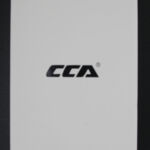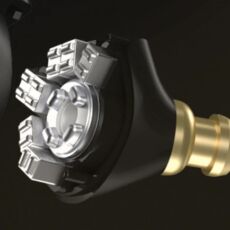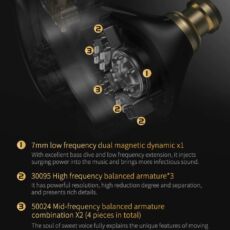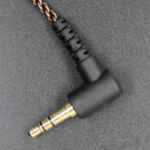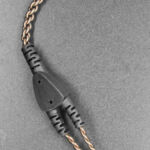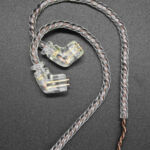CCA Ca16
disclaimer: I have reviewed a lot of KZ gear over the years, some I’ve bought, others were given to me as review samples, and others were purchased at a discount. I think I have every CCA model produced to date in my collection as well. So far CCA is much like its parent, kind of a mixed bag with some models outperforming their price point, others offering average value and one or two that just plain were not good. The CCA Ca16 is a departure from earlier models in that a direct KZ counterpart hasn’t been released yet, so unlike times past where we saw a KZ branded model and then a similar CCA, this time either the CCA came first, or their is not a matching KZ model. Time will tell. I received the Ca16 from Hifigo.com for purpose of this review. I have no financial interest in KZ, CCA, or Hifigo.
Unboxing / Packaging:
The Ca16 comes in a white lift-top style box that is perhaps a bit understated for a new flagship. No graphic of the model on the front and the specs are on a sticker rather than printed on the box itself. Inside, the no-frills packaging continues with the earpieces in a foam block at top and the cable and tips in a small box in the lower portion of the case. The kit is also meager for a flagship model consisting of the earpieces, cable, 3 sets of silicone tips, and the user manual. No case, cable tie, or foam tips are included in the package. It seems obvious that CCA does not see the Ca16 as the flagship as the AS16 still commands nearly double the cost with the C16 still retailing for a higher price at some outlets as well. The Ca16 is the budget 16 driver with the AS16 still remaining in the top spot.
Build/Fit:
The build on the Ca16 is a bit different too. Most of the housing is plastic with the exception of the nozzle and the Ca16 uses the now common semi-custom shape. The shell has more than the usual number of parts though. Looking at the under side of the shell, you can clearly see a seam that divides in the inner shell into the part holding the nozzle and the forward portion of the shell. This forward portion is shallow and rests on top of the main inner shell that runs the entire length of the faceplate. A raised bi-pin connector exits the top front, while the nozzle exits the lowest point of the iem with a slight foward rake. There are two vents on the underside, one near the nozzle and the second in the fold of the shell. These are most easily seen in the 3rd photo below. The seams are not quite as noticeable in use as they are in the photos, but still evident and gives the feel of a limited budget build as it is fairly apparent that fit and polish were not of primary importance.
Internals:
The Ca16 is an 8 driver per ear model with 7 balanced armatures and a single dynamic driver per side. It differs from the previous C16 and AS16 which use balanced armatures for the low end with the 7mm composite diaphragm dynamic providing the lows here. Four 50024 balanced armatures handle the mids and three 30095 balanced armatures handle the highs in the Ca16. The 30095 is in common with the C16 while none of the drivers are common with the AS16. With three 30095 drivers in the mix, this sounds like a recipe for a treble knife, but the crossover is well tuned to keep the top end from getting out of hand and maintaining balanced among the component drivers. Nominal impedance is listed as 24Ω with a sensitivity of 102 dB/mW putting the Ca16 in territory where one would expect it to perform well from a phone or tablet and in my findings it does. It scales qualitatively with source, but quantitatively does not need the additional power of a more potent amp.
Cable:
Those familiar with KZ and CCA will recognize the cable immediately and nothing has changed from previous generations. The south end has the 3.5mm 90º jack with good strain relief before the brown 4 strand copper cable exits. The cable itself is a double twist pattern up to the Y shaped plastic splitter that is entirely too low on the cable, then a pair of 2 strand twists head north to the pre-formed hooks, clear housings, and .75mm bi-pin connectors.
Sound:
Bass:
The Ca16 has good sub-bass quantity with good rumble when called upon and roll-off only becoming noticeable in the lower 30Hz range. Once above about 100Hz, there is a gradual drop off that gives the sub-bass a bit more prominence in the mix compared to the mid-bass but mid-bass retains good slam. Textures are better than expected and I don’t feel the Ca16 gives up much clarity in the bass by going to the dynamic as opposed to the earlier all BA 16 driver models. Speed is good with a bit slower decay than attack leaving just a touch of warmth and bleed at the transition between the dynamic and the Armature as we move into the mids.
Mids:
The transition from mid-bass to lower mids is very well done and smooth and honestly hard to pick out as a result. The lower mids have good clarity and while the Ca16 is a bit V-shaped it is hard to think of the lower mids as recessed. They are not emphasized, but they are far from absent or distant. Tonality is better than expected with strings having a more natural timbre than perhaps any other CCa/KZ model, and several others I have that cost a good bit more. Vocals are well rendered as well with good weight without getting syrupy as a result. Guitar growl is good as well although I would have liked just a bit more edge to them for metal as they seem a touch polite. Upper-mids are a step forward of the lower and as such female vocals step a bit forward. I did not find a tendency toward stridency, but did find that the Ca16 will reproduce sibilance if recorded into the track. Overall, very good mids and way better than I expected at the $55 mark.
Treble:
The lower treble continues the climb of the upper mids and then drops back some as you move into the true treble. It does have a touch of extra energy here, but again not as much as I anticipated with the driver arrangement involved, and not enough to make the treble shy run for the aisles. Treble comes across as well detailed with snare rattle being crisp and only a hint of a metallic edge to high-hat and cymbal (both of which were again better than I anticipated). I think moving the 30095s away from the nozzle probably helped here or perhaps there is something in the crossover design as well that is allowing the detail of the 30095 to show through without the piercing element that so commonly accompanies this driver.
Soundstage / Imaging:
The soundstage on the Ca16 is wider than deep, but does have good reasonable depth to it so doesn’t come across as disproportionate. Seating the orchestra is straight forward with no mis-placements and good instrument separation throughout. Layering is quite good as well with no tendency to compress unless tracks get extremely busy and even then the compression is only evident in the low end provided by the dynamic. It takes something really complex to trip the Ca16 up, I tried. Imaging is both accurate and reasonably precise with points in space well defined and movements easily tracked.
Comparisons:
CCA C16 / KZ As16 –
The comparison here is obvious with the pedigree involved, and to my ear shows the growth of KZ/CCA tuning over the last couple years. The C16 is more analytical, with slightly better detail in the lows, but lacks the extension on the low end of the Ca16, and at the same time packs more top end than the Ca16 giving the AS16 a brighter, hotter top end and a tendency toward sibilance. Overall, there is not a single attribute of the Ca16 that I think the AS16 does better and I suspect the C16/As16 may soon be dropped from their production catalog in favor of the Ca16.
TRN Vx –
Build quality goes to TRN hands down. The cast aluminum shell is better fit, finished, and polished than the Ca16 by a considerable margin. Cables are roughly equal so no points to either in that regard, but sonics go to the Ca16. Starting at the low end, the Vx has more bass, but not as clean. Moving to mids, the Vx does sound recessed vs the Ca16 sounding non emphasized by comparison. At the top end, the VX extends further, but at the expense of sounding harsh at times and being too bright for the treble sensitive. If you love a big V and want slam, the VX may be your pick and I can see it being preferred for watching movies due to that, but for orchestral music, the Ca16 is a big step up.
NiceHck Nx7 Pro –
Here we have a bit closer build quality between the two. Kit is better on the Nx7 as it includes the tuning filters and the case, but it needs those tuning filters to come close to the Ca16 sound wise, and even with the best of them (Silver) it doesn’t have the tonality or the natural timbre to vocals that the Ca16 brings to the table. Mids especially stand out on the Ca16 in comparison.
Thoughts / Conclusion:
A few years ago, we’d have expected a 16 driver in ear to be a proof of concept model and carry a price tag that approached that of a decent used car. Wow how times have changed. Today, we have our choice of multiple 6+ driver per side models in the sub-$100 space, and the options keep growing seemingly weekly. As I write this, I have the TRN VX staring at me as if to say “My turn next”. So where does the CCA Ca16 fit in the grand scheme of things today? To put it bluntly, it ought to be their flagship and they missed a bet by not packaging and marketing it as such. To my thinking it is more coherent, more mature sounding, and just plain an improvement in about every possible way over the earlier AS16 and C16 offerings. Unfortunately, the packaging and build don’t live up to that same standard. Having said that, we are the beneficiaries of that mistake as we now can purchase what I think is the best in-ear CCA has ever offered (and maybe KZ as well for that matter) for the paltry sum of $59. I can promise that while the build is entirely plastic, the cable is typical KZ, and the fit and finish is less than remarkable, the sonics will win you over. Highly recommended.
-
Bass - 7.5/107.5/10
-
Mids - 7.5/107.5/10
-
Treble - 7/107/10
-
Soundstage - 7/107/10
-
Imaging - 7/107/10
Summary


